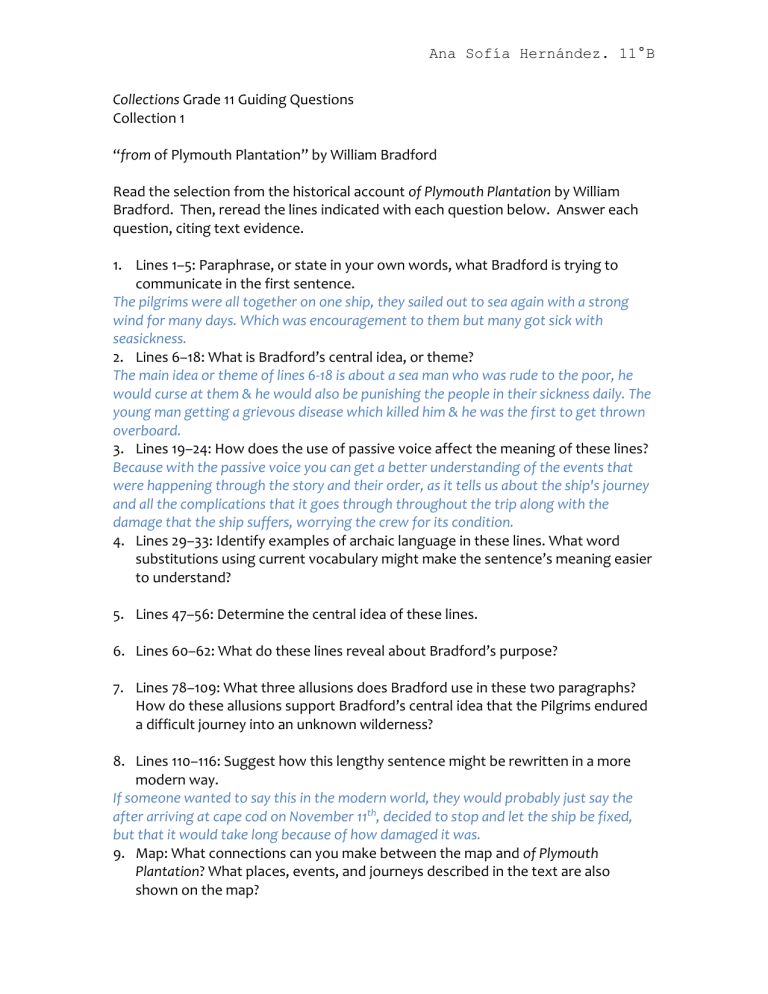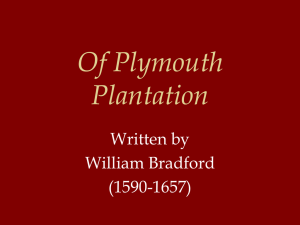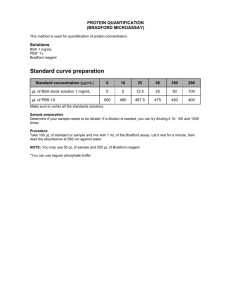
Ana Sofía Hernández. 11°B Collections Grade 11 Guiding Questions Collection 1 “from of Plymouth Plantation” by William Bradford Read the selection from the historical account of Plymouth Plantation by William Bradford. Then, reread the lines indicated with each question below. Answer each question, citing text evidence. 1. Lines 1–5: Paraphrase, or state in your own words, what Bradford is trying to communicate in the first sentence. The pilgrims were all together on one ship, they sailed out to sea again with a strong wind for many days. Which was encouragement to them but many got sick with seasickness. 2. Lines 6–18: What is Bradford’s central idea, or theme? The main idea or theme of lines 6-18 is about a sea man who was rude to the poor, he would curse at them & he would also be punishing the people in their sickness daily. The young man getting a grievous disease which killed him & he was the first to get thrown overboard. 3. Lines 19–24: How does the use of passive voice affect the meaning of these lines? Because with the passive voice you can get a better understanding of the events that were happening through the story and their order, as it tells us about the ship's journey and all the complications that it goes through throughout the trip along with the damage that the ship suffers, worrying the crew for its condition. 4. Lines 29–33: Identify examples of archaic language in these lines. What word substitutions using current vocabulary might make the sentence’s meaning easier to understand? 5. Lines 47–56: Determine the central idea of these lines. 6. Lines 60–62: What do these lines reveal about Bradford’s purpose? 7. Lines 78–109: What three allusions does Bradford use in these two paragraphs? How do these allusions support Bradford’s central idea that the Pilgrims endured a difficult journey into an unknown wilderness? 8. Lines 110–116: Suggest how this lengthy sentence might be rewritten in a more modern way. If someone wanted to say this in the modern world, they would probably just say the after arriving at cape cod on November 11th, decided to stop and let the ship be fixed, but that it would take long because of how damaged it was. 9. Map: What connections can you make between the map and of Plymouth Plantation? What places, events, and journeys described in the text are also shown on the map? Ana Sofía Hernández. 11°B We can see some of the places they have stopped at, we see the territory and the land they’ve been in, we can see the names given at the time as well as dotted lines of where the ship has been and the coordinates. 10. Lines 164–168: How does the story alluded to here relate to the Pilgrims’ experience? From our point of view, we can relate to the Pilgrims in the emotion and even caress of men for going to explore a new place with so many new things and also even the greed of being the first to have all those resources all for themselves. 11. Lines 178–185: What theme does the author want to convey? How does the abandoned corn relate to God’s “providence”? The lack of food they had but the mercy and miracle god gave them to be able to have food (corn) and their gratitude to god’s deed. It relates because in this providence the corn was supposed to be grown, but due to the cold it wasn’t yet they had the seed for next season, which is what became their salvation. 12. Lines 186–207: What words or phrases describe places, events, or people? What kind of feeling do these descriptions convey? Using these clues, what might you infer about Bradford’s purpose? Weather failing, circulating, very cold, froze, sea spray, fire, storm, dancing, Indians. He describes the conditions they´re in and trying to make the reader feel the ambient, through that language He informs the readers of the hardships that the settlers went through in order to reach the new land but they pushed through and stayed strong. 13. Lines 110–224: Find evidence in these lines of repetition in the events Bradford describes. What kind of events does Bradford’s writing focus on? He keeps talking about how the natives react when they arrive to their land, then he also talks about how they have a colorful culture with different beans and food and then about them going back to the shallop to continue their exploration of the new land and the situations they face while getting there, and then he repeats the same but with the new places they find. 14. Lines 234–259: Summarize these lines. How has the action, or pace, changed in this paragraph? What can readers infer about Bradford’s purpose from this paragraph? 15. Lines 260–268: What text evidence suggests that Bradford saw the Pilgrims as having been chosen by God? The evidence that give us is that “Thus is pleased God to get conquer of their enemies” that was his special providence and they have God solemn so thanks for that and the applaud for the deliverance. they saw the Pilgrims as having been chosen by God for leaving seeds to plant crops so they would not starve. God is creator of everything and helped them to get to the new world safely. They were thankful to God for saving them and watching over them over the ocean. They were thankful and blessed God for bringing them safely over the ocean to land again. 16. Lines 269–273: What is the purpose of the paragraph that introduces the Second Book? Ana Sofía Hernández. 11°B In addiction it changes since the way in which it is expressed becomes more formal and authoritative, even a little more firmly to emphasize his point as well in the way of describing more specifically certain events that at the beginning will happen whit more fluency. 17. Lines 285–307: How does the diction of the Mayflower Compact differ from the diction in previous sections of Plymouth Plantation? 18. Lines 308–316: According to the text that comes before this passage, when was the Mayflower Compact signed? How does the brief summary of events in this passage compare to those listed in Chapter X? On November 11th on 1620. The difference is that his summary on chapter X is more based on the culture and curiosity while this one is the more politic side, it also isn’t as repetitive. The Mayflower Compact created laws for Mayflower Pilgrims and nonPilgrims alike for the good of their new colony. It was a short document which established that: the colonists would remain loyal subjects to King James, despite their need for self-governance. 19. Lines 317–322: Look for phrases that are unfamiliar or appear out of context in this sentence. What is a synonym for the phrase “discontents and murmurings”? Are there other substitutions that might make the sentence’s meaning clearer? Although the phrases are out of context their meaning give us a new perspective, Synonym could be what they had complaints and differences, the phrase refers to that when they were in their own territory they would feel more free and in control of themselves. 20. Lines 330–335: Note the active and passive verbs in this sentence. How does the sentence change as it progresses? How does this use of the active and passive voice affect meaning? Because they were the correct words for what to express what he wanted readers to understand from that part of the reading, his point of view and perception of how the Indians approached and behaved. 21. Lines 330–339: What text evidence supports your inferences about the characteristics colonists valued? How might celebrating the characteristics in this account influence Bradford’s readers? 22. Lines 346–349: Why might Bradford have chosen to use phrases like “skulking about” and “stole away”? I believe that before they used more formal ways of speech and because of it he uses the word skulking about and aloof as in they were being mean and inconsiderate but when they approached they would run away. 23. Lines 372–385: Paraphrase the treaty between Massasoit and the Pilgrims and determine its central ideas. 24. Lines 388–395: Summarize Squanto’s life before the Pilgrims’ arrival. 25. Text rubric Ana Sofía Hernández. 11°B The characters of the book are…William Bradford, Captain Standish, Governor John Carver, the Native Indians. But, these men were too mentioned throughout the story: William Butten, Samuel Fuller, William Brewster, Myles Standish, Mr. Dermer, Sir Fernandino Georges The text is about... the journey of William Bradford and other men when they came to the Newland, how long it took them to be able to adapt with the natives and come to an “agreement” of lifestyle in Cape Cod. Describe the setting of the story…although the story makes reference to England and other European countries, the setting is in cape cod, the new land of native Indians, where everything was colorful, from culture, to people, to food. We can see there are many bodies of water surrounding it but also precious treasures. From the map we can also see a more detailed image of what it might’ve looked like. I like when... when Bradford talks about the colorful surroundings of the new world, how it was strange and different, yet attractive for the English. I don't like... that the native Indians felt fear and a need to attack to protect themselves at a certain point of the story.




